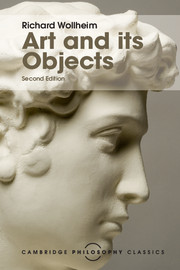Book contents
- Frontmatter
- Dedication
- Contents
- Preface to this edition
- Preface to the second edition
- The argument
- Art and its objects
- Supplementary essays
- 1 The Institutional theory of art
- 2 Are the criteria of identity for works of art aesthetically relevant?
- 3 A note on the physical object hypothesis
- 4 Criticism as retrieval
- 5 Seeing-as, seeing-in, and pictorial representation
- 6 Art and evaluation
- Bibliography
2 - Are the criteria of identity for works of art aesthetically relevant?
from Supplementary essays
Published online by Cambridge University Press: 05 November 2015
- Frontmatter
- Dedication
- Contents
- Preface to this edition
- Preface to the second edition
- The argument
- Art and its objects
- Supplementary essays
- 1 The Institutional theory of art
- 2 Are the criteria of identity for works of art aesthetically relevant?
- 3 A note on the physical object hypothesis
- 4 Criticism as retrieval
- 5 Seeing-as, seeing-in, and pictorial representation
- 6 Art and evaluation
- Bibliography
Summary
In the main body of Art and its Objects I argue – and the argument is completed by the end of section 37 – that works of art fall into two broad categories. Some works of art, like the Donna Velata or Donatello's St George, are individuals: others, like Ulysses or Der Rosenkavalier, are types. Furthermore this division within works of art coheres with another division within art: that into the various arts. Every work of art belonging to the same art belongs to the same category. All paintings, not just some, are individuals: all operas, not just some, are types.
Problems remain about the application of the individual–type distinction. For at least one art (architecture) it is debatable to which category its works belong, and for several arts (poetry, music) whose works are indubitably types it is debatable what are the tokens of these types.
In Languages of Art Nelson Goodman, while recognizing the distinction between what he calls ‘single’ and ‘multiple’ arts, thinks that the more fundamental division within works of art is between the ‘autographic’ and the ‘allographic’. A work of art is autographic if and only if in determining what work of art is in front of us we have to appeal to the history of its production. That the autographic–allographic distinction sorts works of art differently from the individual–type distinction can be seen from the following examples: If I am confronted with a performance putatively of Debussy's String Quartet, then the question whether this is what is really being played is a matter of whether one pattern of sounds (that which I now hear) matches another (identified, let us say, by reference to the score). However, when I am confronted with an impression putatively of Jim Dine' Begonia, then the question whether this is what I am really looking at is a matter of whether the sheet has the right history of production, i.e. whether it comes from the right copper plate. So prints get categorized differently from pieces of music and along with paintings and carved sculpture. Prints are autographic, though they are also types.
Information
- Type
- Chapter
- Information
- Art and its Objects , pp. 112 - 118Publisher: Cambridge University PressPrint publication year: 2015
